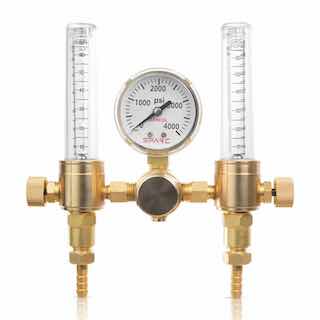Welding Project - Fabricating a Belt Guard for an Air Compressor
This weeks video is a quick welding project. A belt guard for an air compressor fabricated out of 16 ga carbon steel.
An air compressor is extremely useful but in a pinch I can get by without one.
Thats
because I have several electric grinders. 4 and 4 1/2" 90 grinders,
straight grinders, dewalt, milwaukee, ryobi, makita, and even a harbor
freight straight grinder that will hurt you if you are not extra
careful.
see the part 2 fabricating video here with tig welding the outside corner joints, and other tips
My welding shop is inside a machine shop with CNC equipment. And when the air goes down, they aint making any parts.
Shop air to a CNC machine shop is almost like electricity is to a welding shop. Without it, you are dead in the water.
Well, the main compressor starting to lose its mind a week ago so
that was a wake up call....and now we are setting up a backup
compressor.
A nearby shop had an old compressor outside in the lay down yard.
It was free, but it has also been outside for a while and has no belt guard. That is unsafe.
It reminds me of a big fan we had in the house when I was a kid...no
guard at all and if you stuck your finger in the fan just to see what would happen..., you would never do it a second time.
I remember
all kinds of things like that growing up. Like an old washing machine
motor with a grinding wheel on it for a bench grinder. (Of course there
was no guard on it.) A lawn edger with no guard ...very dangerous.
Well today, things are different. We have been made much more aware of the need to be safety conscious....What we overlooked 50
years ago, we cringe at as being terribly unsafe in this day and time.
And dont get me wrong, I am all for being safe. But sometimes it can go too far.
For example, I had a comment on a
video a few years ago about grinder guards. One fella ranted that in 30
years of work, he had never used a grinder without a guard and had zero
tolerance for anyone who made excuses as to why they had to remove the guard
to get in a tight area.
Well, all I can say is that he must have worked in a different universe than me.
Over the years, I have been into all kinds of areas where a grinder guard completely prevents any reasonable access.
For example, If you have to use a mirror to weld it, how you gonna get to it to grind it with a guard?
I am all for safety. But common sense has to be part of the equation too.
I even worked one place where every bench vice on every workbench had to have rubber washers
on each side of the handle or you would get written up. Why? because someone once got pinched and got a blood blister from
the handle.
I am just saying.
Ever see the photograph of construction workers having lunch on a
beam at the Rockefeller center building sometime around 1932? Its a famous photograph.
Today, It gets a
reaction. It makes some people cringe. Yet no one on the beam seemed to
be cringing at all. No safety belts, no harnesses, no hardhats. Just a
bunch of men having lunch on a beam that happened to be hundreds of
feet high.
Enough of the rant. Lets move into the welding project.
So
before we get this air compressor piped in and up and running, I am
going to fabricate a belt guard so that nobody accidentally sticks 5
fingers in and only pulls out 4.
Here is how I am approaching this welding project:
- get dimension between centers of pulleys and radius of pulleys
- use plasma cutter to cut 4 inch strips and 1 inch strips from left over 16 ga carbon steel sheet metal
- use circle cutter attachment to cut radius lip pieces that are 2 inches larger radius than pulleys to allow for adequate clearance.
- clean all the edges with a 4 1/2" grinder flapper wheel for tig welding
- roll 4 inch wide pieces using pvc pipe and whatever else is available for a mandrel
- make end pieces first, clamp in place according to distance between pulley centers
- mark and cut pieces to fill in the gaps.
- tack weld every 2 inches or so and then weld out.
I made a downdraft table several months ago that really comes in handy for welding projects like this.
You can see how well it works as I burn a paper towel and then switch on
the Miller fume extractor. Literally all the smoke from the burning
paper towel goes down and gets filtered by the fume extractor....and it
works the same for plasma cutting, welding galvanized, silver brazing
with flux, and all the other jobs that make fumes that you shouldn't
breathe.
If you are interested in seeing the pages on fabricating the downdraft cutting table click here.
Another
welding project I did months ago was a stand for a Porter Cable
portable band saw. It is one of the most useful things in the shop more
making quick cuts on round stock, threaded rod, and for quick sheet
metal cuts like I did in this video. You can see it here.
I know there are better ways to go about a welding project like
this. But sometimes, you just have to make up you mind and drive on in
order to get something done in a reasonable time. One thing I would
have done differently is to carry the curvature of the large pulley side
a little further so that the curve would have transitioned into the
straight line nicer. Not a big deal like it is but it would have looked
better.
Also, I was going to try out a Freud Diablo metal saw blade for those
straight cuts. But I will do that in a future video for all those that
dont have a plasma cutter.
Trick for tack welding.
I used
the HTP 221 tig welder again for this video and it has a spot timer for
quick burst tack welding. Usually, I just set the machine to about
twice what I would use to weld and then pump the foot pedal as quickly
as I can. It makes for very small and very quick tack welds. But a word
of caution: practice this technique on scrap metal first or you may blow
holes. It is kind of an advanced technique for tack welding and with
125 amps on 16 ga sheet metal, you better be quick.
The HTP 221 has a setting for tack welding and I set the machine to
125 amps and .2 seconds. just to be extra clear, that is 2 tenths of a second....0.2
seconds.
Part 2 of this Video will be the actually welding of all
those outside corners as well as the expanded metal inlay and mounting
brackets.
Stay tuned.
see more welding projects
and here is the link for that wide base square













